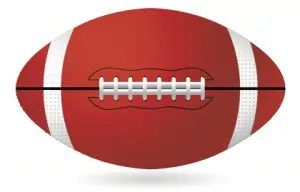hash marks
What Is The Definition Of Hash Marks In Football?
In American football, hash marks are a series of small white lines, or hashes, parallel to the sidelines. Hash marks are integral to fans, referees, and players in spotting locations on the field and interpreting visual distances. Variations of hash marks are used but slightly differ for American professional, collegiate, high school, and Canadian football.
How Are Hash Marks Spaced In Football?
Since 1972, the NFL has placed hash marks 70 feet, 9 inches from the sideline, and 18.5 feet apart.
In the NFL and indoor football leagues, the hash marks align with the goalposts. That’s not the case for high school, college, and the Canadian Football League, whose hash marks are slightly wider than the goalposts.
In college football, hash marks are 20 yards from the sideline and 40 yards apart.
What Is The Origin Of Hash Marks?
You can thank extremely cold weather for advancing the hash mark in football.
In a 1932 playoff game, the Chicago Bears played the Portsmouth Spartans that moved from Wrigley Field to Chicago Stadium, an indoor arena. The field was only 80 yards long and included several rule adjustments. The sidelines were shored up with hockey-type boards, the goalposts were moved to the goal line, and for the first time, the ball was not spotted along the sideline.
Up until that point, plays that ended near the sideline were spotted there. If a player caught or carried the ball out of bounds, the play was spotted 15 yards from the sidelines. Throughout games in the 1920s, coaches were wasting plays by getting out of bounds to gain optimal positioning away from the sidelines, similar to how quarterbacks spike the ball today.
After the 1932 playoff game, the NFL diverged from the college rule book and placed hash marks 10 yards from the sideline. Hash marks have been critical to the advance of the game. Following the rule change, teams had a better understanding of where they could run the ball, whether to the left or the right. It also freed ends to move out wider to the edges of the field as receivers and made the game much more dynamic in balancing running and passing plays with a defense tasked with figuring it all out.
Update Of Hash Marks Changes The Game For Announcers And Fans
In 1954, Wisconsin native John Lockney had an idea to help improve the game’s visibility for fans.
There are 320 of these lines that run along the sideline parallel to the hash marks that intersect yard lines. He introduced these lines to a high school football game in Wisconsin, and in 1955, they were implemented for a nationally-televised game at the University of Wisconsin. The Green Bay Packers took note and added them, which became mandatory by committee in 1956.
Example Of How Hash Mark Is Used In Commentary
1. As a right-footed kicker, in game-winning situations, Mason Crosby’s go-to hash is the left hash mark.
2. The ball will be spotted on the hash mark just shy of the 45 yard-line.
Sport The Term Is Used
1. Football